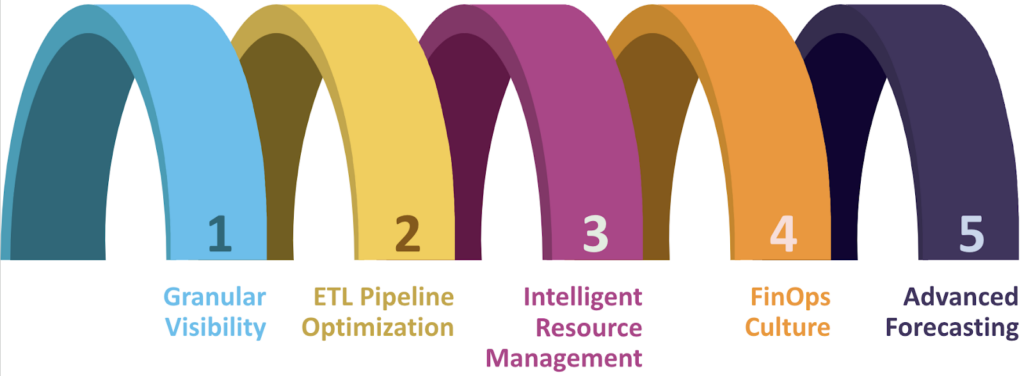According to Forrester, accurately forecasting cloud costs remains a significant challenge for 80% of data management professionals. This struggle often stems from a lack of granular visibility, control over usage, and ability to optimize code and infrastructure for cost and performance. Organizations utilizing modern data platforms like Snowflake, BigQuery, and Databricks often face unexpected budget overruns, missed performance SLAs, and inefficient resource allocation.
Transitioning from reactive spending to proactive optimization is crucial for effective cost management in modern data stack environments.

This shift requires a comprehensive approach that encompasses several key strategies:
1. Granular Visibility
Gain comprehensive insights into expenses by unifying fragmented data and breaking down silos, enabling precise financial planning and resource allocation for effective cost control. This unified approach allows teams to identify hidden cost drivers and inefficiencies across the entire data ecosystem.
By consolidating data from various sources, organizations can create a holistic view of their spending patterns, facilitating more accurate budget forecasting and informed decision-making. Additionally, this level of visibility empowers teams to pinpoint opportunities for optimization, such as underutilized resources or redundant processes, leading to significant cost savings over time.
2. ETL Pipeline Optimization
Design cost-effective pipelines from the outset, implementing resource utilization best practices and ongoing performance monitoring to identify and address inefficiencies. This approach involves carefully architecting ETL processes to minimize resource usage while maintaining optimal performance.
By employing advanced performance tuning techniques, such as optimizing query execution plans and leveraging built-in optimizations, organizations can significantly reduce processing time and associated costs. Continuous monitoring of pipeline performance allows for the early detection of bottlenecks or resource-intensive operations, enabling timely adjustments and ensuring sustained efficiency over time.
3. Intelligent Resource Management
Implement intelligent autoscaling to dynamically adjust resources based on workload demands, optimizing costs in real-time while maintaining performance. Efficiently manage data lake and compute resources to minimize unnecessary expenses during scaling. This approach allows organizations to provision automatically and de-provision resources as needed, ensuring optimal utilization and cost-efficiency.
By setting appropriate scaling policies and thresholds, you can avoid over-provisioning during periods of low demand and ensure sufficient capacity during peak usage times. Additionally, separating storage and compute resources enables more granular control over costs, allowing you to scale each component independently based on specific requirements.
4. FinOps Culture
Foster collaboration between data and finance teams, implementing cost allocation strategies like tagging and chargeback mechanisms to attribute expenses to specific projects or teams accurately. This approach creates a shared responsibility for cloud costs and promotes organizational transparency.
By establishing clear communication channels and regular meetings between technical and financial stakeholders, teams can align their efforts to optimize resource utilization and spending. A robust tagging system also allows for detailed cost breakdowns, enabling more informed decision-making and budget allocation based on actual usage patterns.
5. Advanced Forecasting
Develop sophisticated forecasting techniques and flexible budgeting strategies using historical data and AI-driven analytics to accurately predict future costs and create adaptive budgets that accommodate changing business needs. Organizations can identify trends and seasonal variations that impact costs by analyzing past usage patterns and performance metrics.
This data-driven approach enables more precise resource allocation and helps teams anticipate potential cost spikes, allowing for proactive adjustments to prevent budget overruns. Additionally, implementing AI-powered forecasting models can provide real-time insights and recommendations, enabling continuous optimization of environments as workloads and business requirements evolve.
Mastering these strategies can help you transform your approach to cost management from reactive to proactive, ensuring you maximize the value of your cloud investments while maintaining financial control.
To learn more about implementing these cost management strategies in your modern data environment, join our upcoming webinar series, “Controlling Cloud Costs.” This ten-part series will explore each aspect of effective cost management, providing actionable insights and best practices to gain control over your data platform costs.


